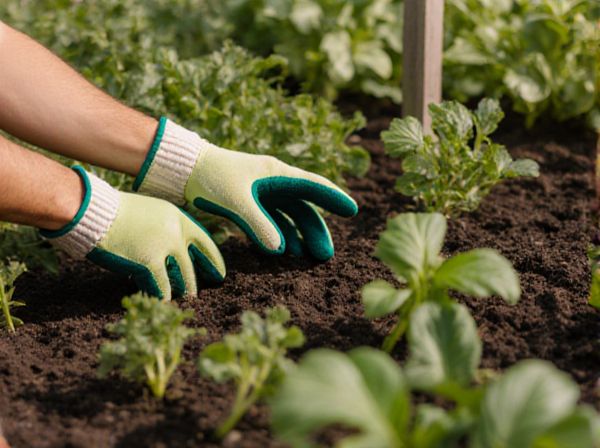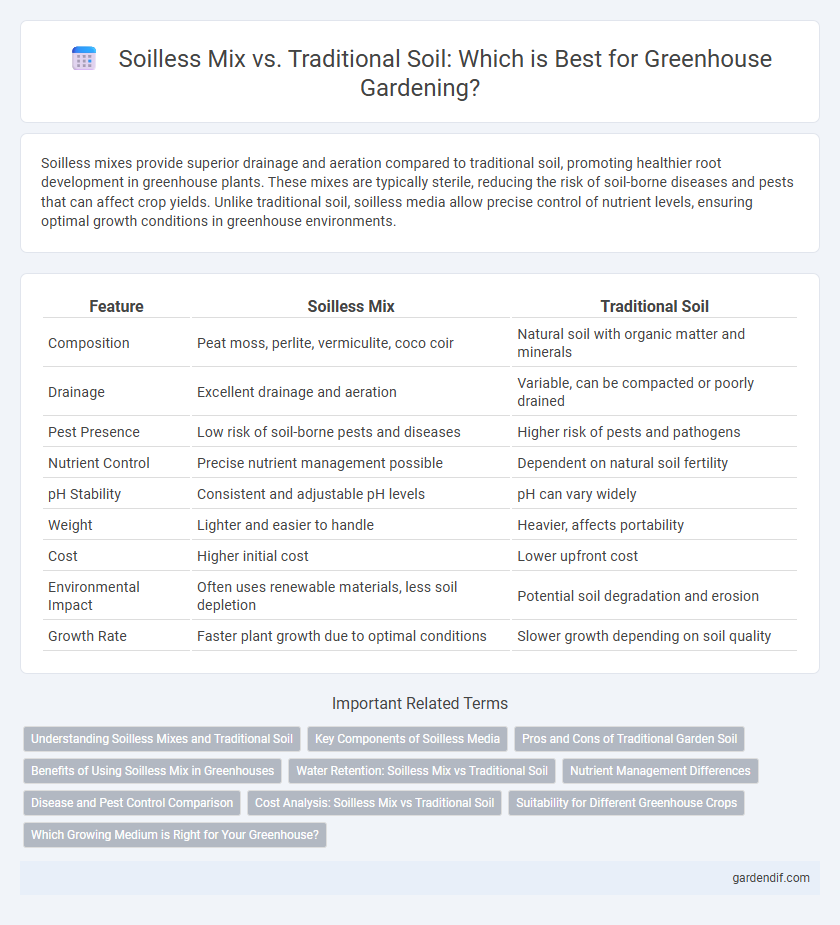
Soilless mix vs Traditional soil Illustration
Soilless mixes provide superior drainage and aeration compared to traditional soil, promoting healthier root development in greenhouse plants. These mixes are typically sterile, reducing the risk of soil-borne diseases and pests that can affect crop yields. Unlike traditional soil, soilless media allow precise control of nutrient levels, ensuring optimal growth conditions in greenhouse environments.
Table of Comparison
| Feature | Soilless Mix | Traditional Soil |
|---|---|---|
| Composition | Peat moss, perlite, vermiculite, coco coir | Natural soil with organic matter and minerals |
| Drainage | Excellent drainage and aeration | Variable, can be compacted or poorly drained |
| Pest Presence | Low risk of soil-borne pests and diseases | Higher risk of pests and pathogens |
| Nutrient Control | Precise nutrient management possible | Dependent on natural soil fertility |
| pH Stability | Consistent and adjustable pH levels | pH can vary widely |
| Weight | Lighter and easier to handle | Heavier, affects portability |
| Cost | Higher initial cost | Lower upfront cost |
| Environmental Impact | Often uses renewable materials, less soil depletion | Potential soil degradation and erosion |
| Growth Rate | Faster plant growth due to optimal conditions | Slower growth depending on soil quality |
Understanding Soilless Mixes and Traditional Soil
Soilless mixes, composed of materials like peat moss, perlite, and vermiculite, offer superior aeration, drainage, and disease resistance compared to traditional soil, which often contains variable organic matter and microorganisms. These mixes provide a controlled environment that enhances root development and nutrient uptake, essential for greenhouse cultivation. Traditional soil can introduce pests and pathogens but is valued for its natural nutrient content and microbial activity that supports plant growth.
Key Components of Soilless Media
Soilless mix in greenhouses primarily comprises components like peat moss, perlite, vermiculite, coir, and sometimes bark, offering superior aeration and drainage compared to traditional soil. These substrates provide a sterile, lightweight, and uniform growing medium that minimizes pests and diseases while ensuring optimal root oxygenation and moisture retention. Unlike traditional soil, soilless media eliminate variability and contamination risks, enhancing plant growth and nutrient management precision.
Pros and Cons of Traditional Garden Soil
Traditional garden soil offers natural nutrients and beneficial microorganisms that support plant growth and improve soil structure over time. However, it can be prone to pests, diseases, and inconsistent moisture retention, which may affect greenhouse crop yields. Additionally, garden soil often requires sterilization and amendment to optimize drainage and prevent compaction in controlled environments.
Benefits of Using Soilless Mix in Greenhouses
Soilless mix in greenhouses offers superior drainage and aeration compared to traditional soil, reducing the risk of root diseases and promoting healthy plant growth. Its sterile composition minimizes pests and pathogens, enabling precise nutrient management and consistent crop yields. This controlled environment fosters faster root development and efficient water usage, enhancing overall greenhouse productivity.
Water Retention: Soilless Mix vs Traditional Soil
Soilless mixes, composed primarily of peat moss, coconut coir, and perlite, offer superior water retention compared to traditional soil due to their uniform particle size and enhanced aeration properties. Traditional soil, with its varied composition of sand, silt, and clay, often drains water unevenly, leading to potential overwatering or drought stress in greenhouse plants. Optimizing water retention through soilless media promotes consistent moisture levels, essential for root health and maximizing crop yield in controlled greenhouse environments.
Nutrient Management Differences
Soilless mixes, composed of inert materials like coconut coir or perlite, allow precise nutrient management by delivering tailored hydroponic solutions directly to plant roots, ensuring optimal uptake and minimizing nutrient runoff. Traditional soil relies on its natural organic matter and microbial communities to cycle nutrients, often resulting in less uniform nutrient availability and potential nutrient immobilization. Soilless systems require more frequent monitoring and adjustment of nutrient concentrations, while traditional soil benefits from buffering capacity but may face challenges with nutrient leaching and pH fluctuations.
Disease and Pest Control Comparison
Soilless mixes significantly reduce the risk of soil-borne diseases and pests by eliminating harmful pathogens commonly found in traditional soil, enhancing plant health in greenhouse environments. Unlike traditional soil, soilless media are sterile and provide better drainage and aeration, which minimizes root diseases such as damping-off and root rot. The use of soilless substrates also facilitates easier pest management by reducing habitats for pests like nematodes and soil-dwelling insects.
Cost Analysis: Soilless Mix vs Traditional Soil
Soilless mix generally incurs higher initial costs due to premium materials like coco coir, perlite, and vermiculite compared to traditional soil, which is often cheaper and locally sourced. Operational expenses for soilless media may be lower since it offers better drainage and aeration, reducing plant diseases and improving growth efficiency. Traditional soil's cost-effectiveness can be offset by potential issues such as compaction and nutrient inconsistencies, which may require additional amendments and labor over time.
Suitability for Different Greenhouse Crops
Soilless mixes, composed primarily of peat, coconut coir, and perlite, offer superior drainage and aeration, making them ideal for hydroponic crops like lettuce and tomatoes that require precise water and nutrient control. Traditional soil, rich in organic matter and beneficial microorganisms, supports root development and nutrient availability, favoring crops such as cucumbers and peppers that thrive in a more natural growing medium. Selecting the appropriate substrate depends on crop-specific needs, environmental control within the greenhouse, and disease management priorities.
Which Growing Medium is Right for Your Greenhouse?
Soilless mix offers superior drainage, aeration, and disease control compared to traditional soil, making it ideal for hydroponic greenhouse systems and plants requiring precise nutrient management. Traditional soil provides natural microbial activity and nutrient buffering, benefiting crops that thrive in stable organic environments and reducing the need for frequent nutrient adjustments. Choosing the right growing medium depends on your crop type, irrigation control, and greenhouse system, with soilless mixes favored for controlled environments and traditional soil preferred for organic, low-maintenance cultivation.
Soilless mix vs Traditional soil Infographic

 gardendif.com
gardendif.com